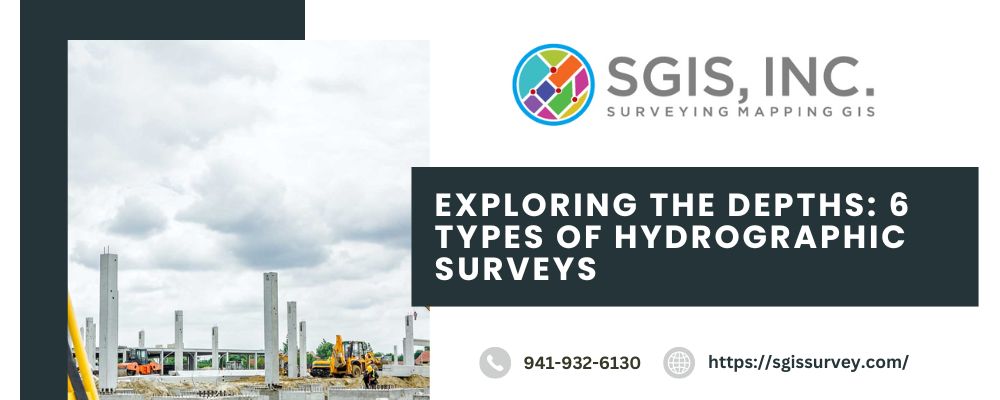
Exploring the Depths: 6 Types of Hydrographic Surveys
As we know, 70% of the world is covered in water. Building ships requires the same level of comprehension as building the bottom and underlying topography. This can be accomplished through hydrographic surveys (underwater studies). This blog will cover a selection of hydrographic surveys and the tools needed to conduct them. Depending on the project and the information required, we at SGIS, Inc., a professional survey company, help you understand what is beneath the surface by carrying out different surveys.
A hydrographic survey includes taking pictures of the water levels at various locations. It is the basis for many waterbody management agencies’ decisions about the quantity and type of water they have, including ports, dams, and councils. If you’d like to know more about this type of survey, keep reading this blog for a more profound knowledge of hydrographic surveys.
Hydrographic surveying: What is it?
Marine research focuses on finding subsea features. Geography, tidal data, and water depths are examined. Understanding the shapes and elevations of the ocean floor has several applications. Hydrographic surveys (measurements) cannot be carried out without bathymetric surveys. Bathymetry data is gathered by a moving ship rather than a study from land. As such, any faults arising from this change must be closely monitored.
The primary goal of hydrographic surveying is to ascertain the depths of water bodies. Numerous applications exist for hydrographic surveying, including wreck identification, dredge surveys, and canal construction. Surveying is used when building docks, dams, and harbors. For ships to enter and exit dock safely, ports need to have a sufficient depth of water. Submerged surveying is employed to get information for extensive construction endeavors. Surveying technology can be used to do remote maintenance on oil and gas infrastructure. In the future, hydrographic investigations might eliminate the need for human inspections. Surveying makes it possible to build appropriate pipe tracks during the installation of underwater pipes.

6 Types Of Hydrographic Surveys:-
Although many subcategories might be used, hydrographic surveys can be divided into six main types.
1. General Hydrographic Surveys:
Examine bathymetric maps, mean sea level, water depth, and shoreline identification. These are the surveys that are most commonly seen. These surveys are helpful for a number of scientific and geological research applications.
2. Wreckage Surveys:
Wreckage surveys are carried out in order to pinpoint the precise location of the wreckage, which only a professional survey company can do. It could be carried out as part of the salvage operation itself or as part of an investigation to determine the most likely reason why the vessel sank. Internal flooding causes floating boats to sink. Highly skilled hydrographers could look into the location of the wreckage. They could shed information on the possible origins of flooding as well as the extent of structural damage. During salvage operations, it is imperative to prevent damaging the vessel or the surrounding area. It is able to determine the viability of a salvage method by conducting tests near the wreck.
3. Underwater asset management:
An underwater asset management survey is needed to ensure that submerged assets that support structures above the water line—like bridges—are safe and haven’t been eroded or damaged.
4. Harbour Surveys:
Harbour Surveys are being carried out to identify the best sites for these facilities. National governments must determine the best locations that don’t impede boat access due to drought. It is difficult for ships to reach the mainland, for example, when coral reefs surround them in lagoons. A port’s construction cannot begin unless a number of problems are resolved.
5. Passage Surveys:
Passage surveys are carried out in order to make interior waterways usable for navigation. They assess the state of inland waterways and offer recommendations for their advancement. This study will look at the mean draft, passage width, and the largest ships that can sail through the channel in order to increase trade and productivity. Furthermore, studies of transit are being conducted to see whether it would be feasible to construct straits like the Suez and Panama Canal.
6. Coastal Surveys:
Coastal Surveys record the flora and animals found there and nearby and learn about a nation’s coastline. These surveys are frequently carried out inside a nation’s marine borders, which might extend up to 200 nautical miles beyond the border. They also support research into potential projects for beach renourishment and land reclamation.
Hire Us, The Professional Survey Company Today!
These hydrographic surveying assessments are beneficial in research areas where approximations of hydrographic parameters are allowed. They are conducted for military purposes, geological reasons, to locate infrastructure related to oil and gas, and to set up underwater communication networks. We are a well-known professional survey company with many happy clients. Visit our website to learn more about us.

No Comments :